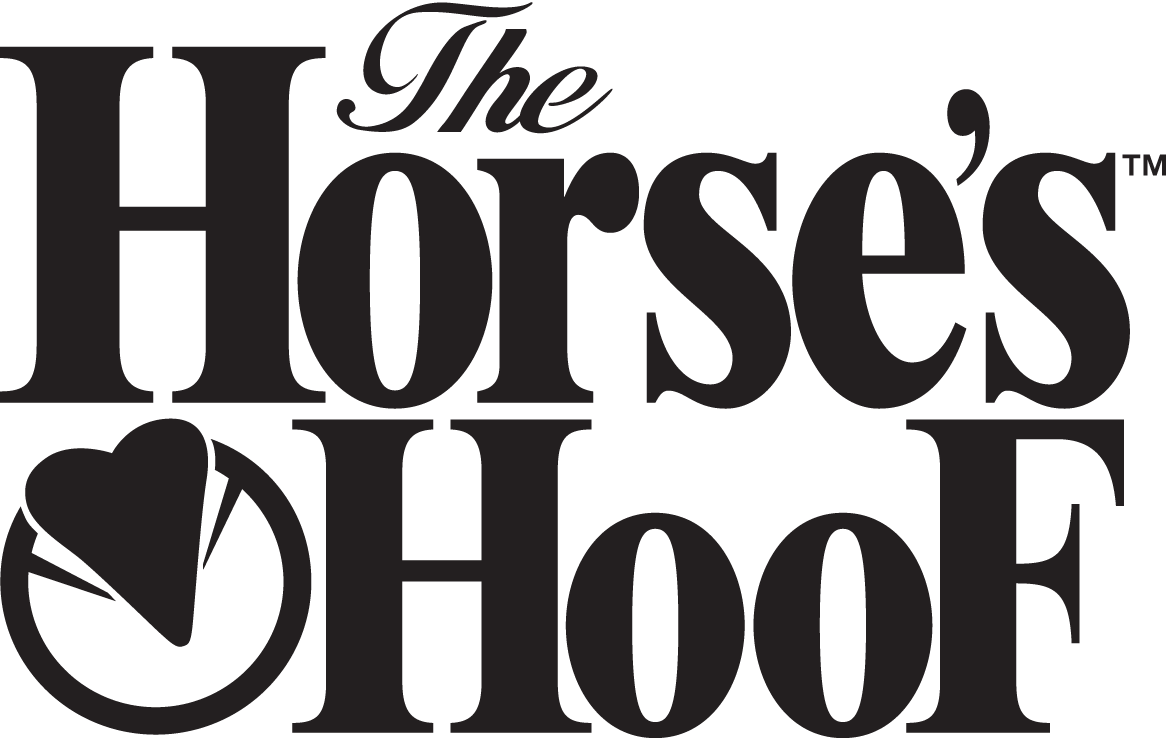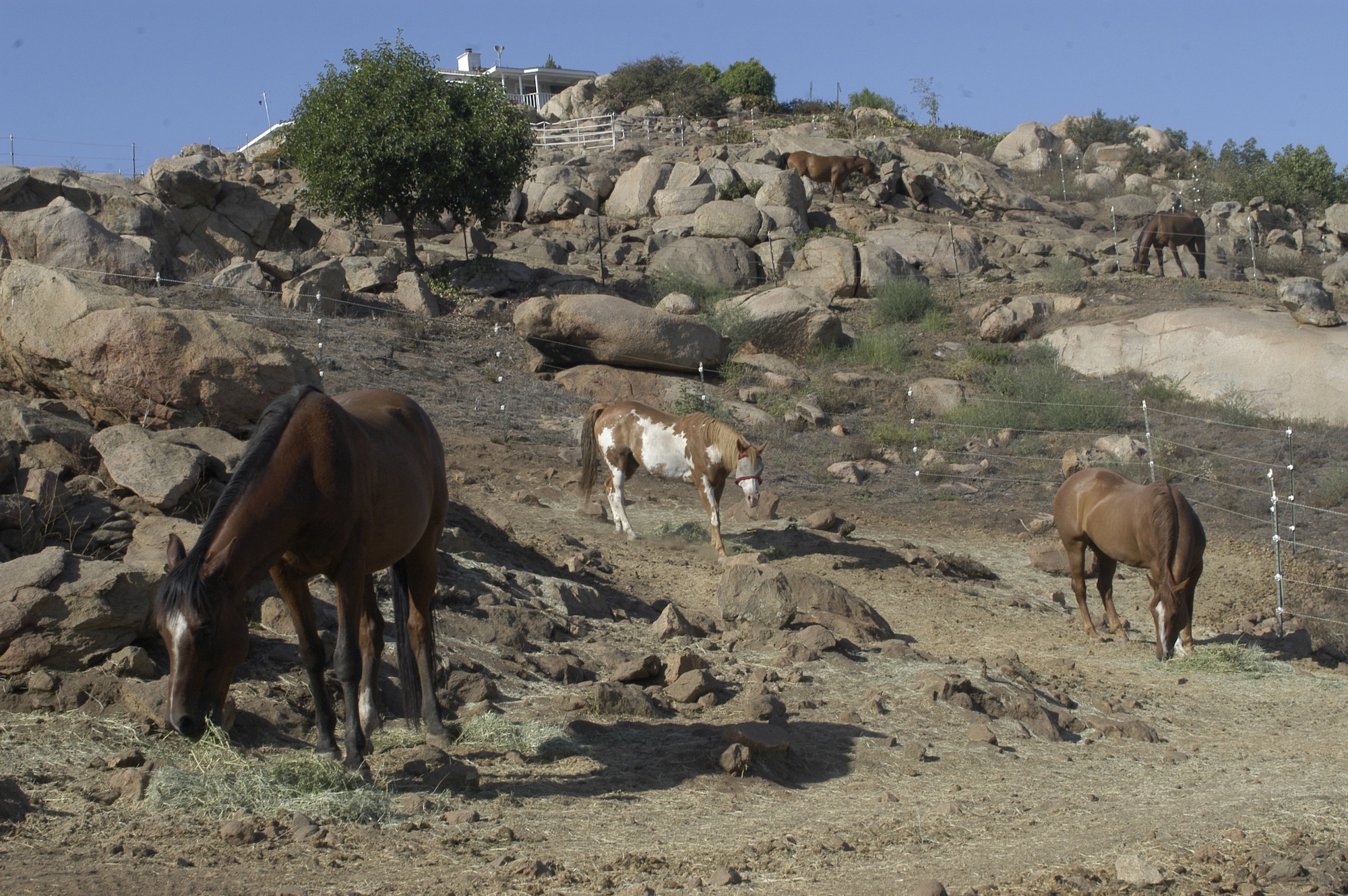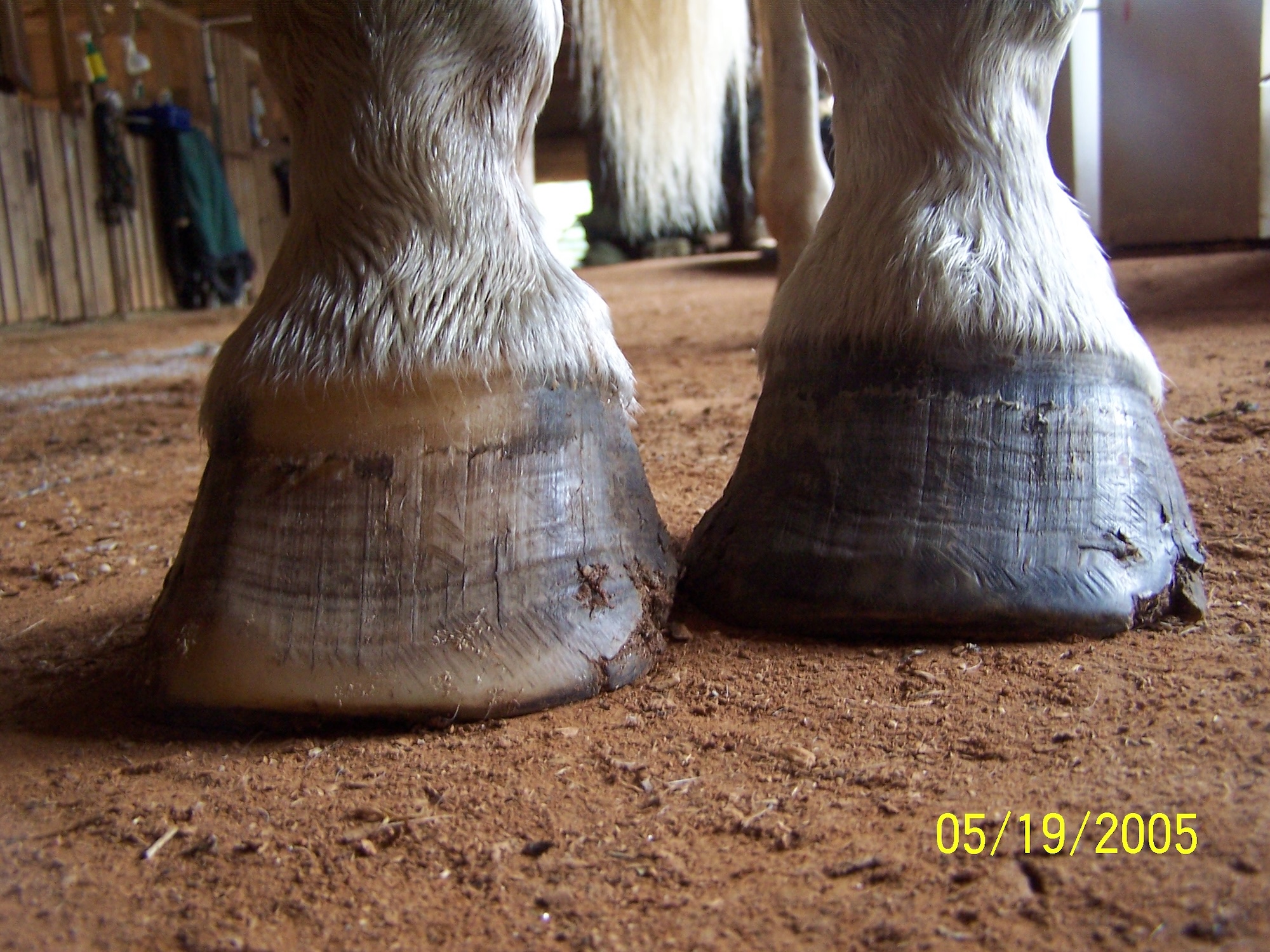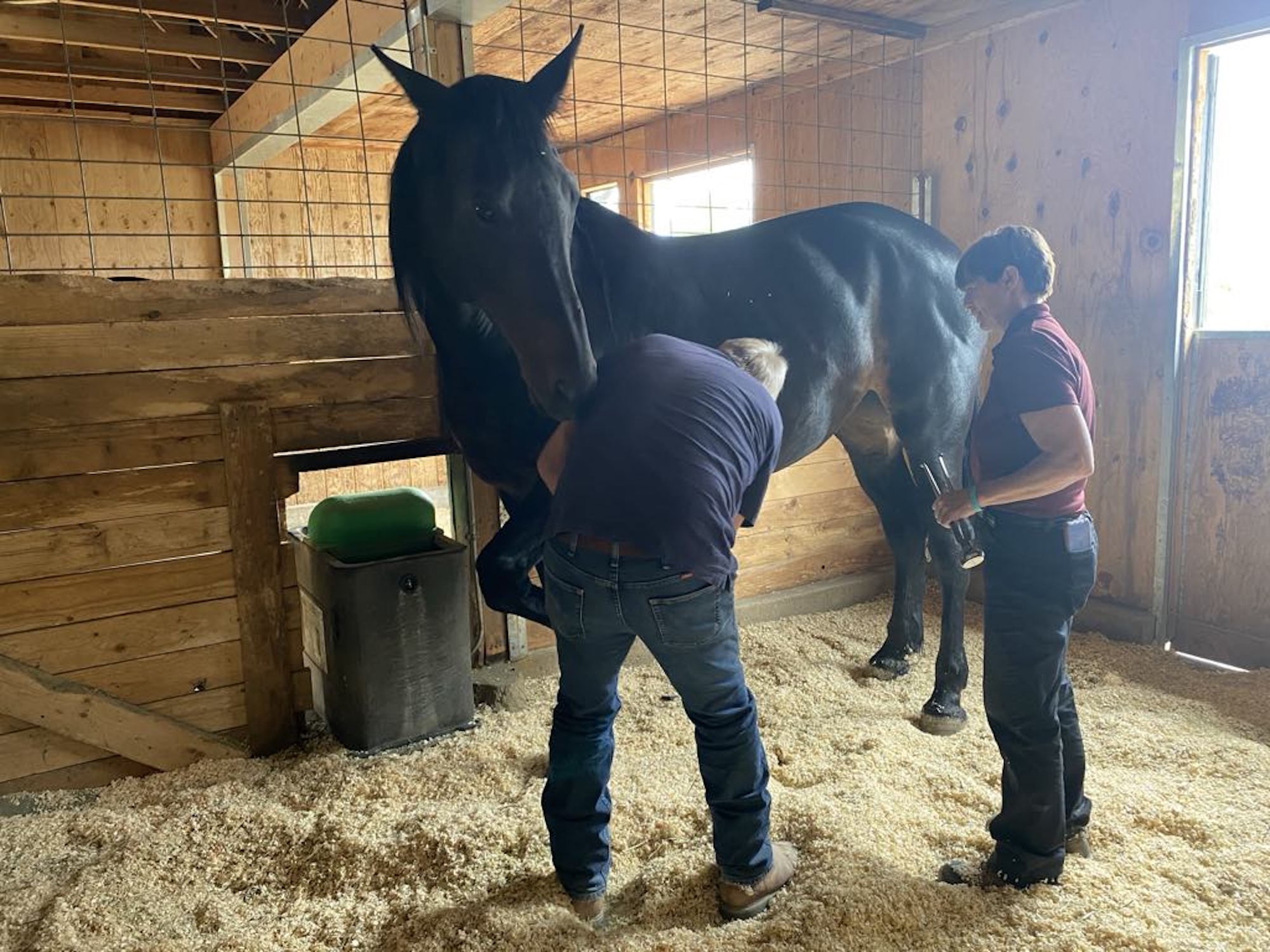Empty stalls and naked feet…that’s the heart of the message that Joe Camp is trying to spread to all the horse lovers of the world.
And even if Joe’s name didn’t ring a bell, you probably know who he is: remember Benji, that canine superstar who pulled on our heartstrings? Is it any wonder that the man who created the Benji movies would find that special connection to horses that draws one towards natural horse care?
A lifelong animal lover, Joe entered the horse world quite recently. His fresh eyes soon scrutinized traditional horse care practices. His compelling story is best told in his own words, available soon in his upcoming new book – but here’s a preview below, from my conversation with Joe. – Yvonne Welz
All photos courtesy Joe Camp.

“Our 1 1/2 acre natural pasture was created inside a perimeter chain link fence, utilizing an inexpensive Premiere 1 electric fence system that creates a big circle around a smaller circle, in which hay is distributed morning and evening. They pretty much move around this large circle all day long.”
Yvonne Welz interviews Joe Camp:
Yvonne: Please share with us the story of how you first became aware of, and then involved in, natural hoofcare.
Joe: Kathleen and I were rank novices with no idea what we were doing when we took our blind leap into the world of horses. That was just two short years ago. Our first three went straightaway into stalls, wearing shoes, eating from table-high bins. We were told, “that’s the way it’s done.” Who were we to question? We were blank slates. But as our journey unfolded, and we began to peel back the layers of this truly enigmatic horse world, we found ourselves mystified at our discoveries.
Most of the early information we gathered about traditional horse care, when applied against a body of logic, didn’t seem to make any sense. We seriously began to scratch our heads and say what’s going on here? Why, for example, is it okay to put a beast who has been running on the plains for fifty million years into a 12×12 cage. There have to be some genetic issues with that. Why does a flight animal, who has survived on his own, without humans, all that time, need metal shoes?
The folks we asked would generally shrug and, again, say, “that’s just the way it’s done.” Fortunately, along the way, we stumbled onto Monty Robert’s Join Up as a way to begin a relationship with each of our horses. When my horse, Cash, willingly made the choice to walk up behind me in the round pen and nuzzle my shoulder, he was saying I trust you. And that changed everything. Literally. I was no longer an owner, but rather a trusted leader. I realized that I not only loved this horse, but I was truly responsible for his happiness and health. And that left me no choice but to do the work, to gain the knowledge, to make the right decisions for him, and all our horses. I was now emotionally involved, and that meant commitment.
We dug deeper, consuming books, articles, and DVDs until I thought my head was going to burst, cramming at light speed to make up for all the years of experience that we didn’t have. To learn what makes these wonderful animals tick. There had to be better answers.
It wasn’t long before I began reading everything I could find about feet, because Cash had come to us wearing only two shoes, on his fronts. I wanted to know why he didn’t need shoes on his rear feet, as well. After all, it was at least a quarter of a mile walk on asphalt to the local horse club arena. And his feet must be protected, right? I hadn’t yet discovered wild horses, but I was about to. I came across a magazine article that began by saying: a horse’s hoof is supposed to flex with every step taken. Huh?
The article went on to say that the simple act of the hoof flexing is just about the most important thing for a horse’s good health and long life. It provides shock absorption for the joints, tendons and ligaments, acts as a circulatory pump for blood in the hoof mechanism, and helps the heart get that blood flowing back up the leg. And with a metal shoe nailed to the hoof, no flexing can occur.
I was dumbfounded. Logic has always been my long suit. So how could this have escaped me? I scurried to the internet and found Jaime Jackson’s wild horse research, and Pete Ramey, and Eddie Drabek, and this publication. And in a heartbeat, I was asking the same questions most of your readers must be asking. How have we humans been so misguided for so long?
The next day, Cash’s front shoes came off, and he received my kindergarten version of the wild horse trim. Fortunately, we soon found Marci Lambert, our new natural hoof care specialist, and Cash no longer had to put up with my fumbling. Over the next few weeks, the shoes on our five other horses came off, and we’ve never looked back. To steal Pete Ramey’s phrase, we are now the proud parents of twenty-four “rock-crushing hooves.”

Above: Cash, an 11 yo Arab, is the clever star of Joe’s book “The Soul of a Horse”. Below: Cash’s hooves. “He dances up the rocks of our natural pasture like a mountain goat.”


Yvonne: It seems like so many folks just ignore the available information about barefoot and natural care, unless they are actually seeking help for a lame horse, usually suffering from severe founder or navicular. One of our missions here at The Horse’s Hoof is to reach people WAY before disaster strikes – to reach the ordinary horseowners before the hooves crash. Why do you think that the barefoot concept really clicked for you, so quickly, when you had no real hoof problems with your horses?
Joe: I’m not so sure most folks are ignoring the information. I don’t think they know it’s available. When we began this journey, we weren’t even sure that wild horses still existed. We certainly didn’t know that they had been around for fifty-five million years. So, like most, we had given no thought to how they had survived all that time with no assistance from humans. We had never read Dr. Strasser, or Jaime Jackson, or Pete Ramey, or sought out your website or publication, so we didn’t know about all the research into the amazing health and soundness of wild horse hooves. So, of course, it follows that we had no idea why it was so. We simply had no knowledge of any of it, so how could it apply to us? Which, unfortunately, is the case with most of the folks we’ve run into. Even those with years of experience. They haven’t been exposed to it, so there’s no relevance to them. We need to be more tenacious about making sure they’re exposed to it.
For us, I suspect that coming at it with a clean plate had a lot to do with being receptive. We had no past filled with bad experiences. And once my brain was pried open, the logic was irrefutable. It made sense. But so many folks who we’ve tried to convince have had some negative experience that they believe is evidence that shoes are best. Like the lady who said to me, “When my horse’s shoe falls off, he starts limping almost immediately. And when the shoe is nailed back on, suddenly he’s fine. Doesn’t hurt anymore. Proof that the shoe is better for him than barefoot.”
I asked her if she had ever crossed her legs for so long that her foot went to sleep? We all have, and we all know what’s happening. The leg cross cuts off the circulation to the foot, and with no circulation, the nerve endings lose their sensitivity and fail to work. The second you uncross, or stand up, the circulation returns, as do the nerve endings. Ooohh! Ouch!
The same thing happens to a horse when a metal shoe is nailed on. The inability of the hoof to flex removes its ability to pump blood, virtually eliminating circulation in the hoof mechanism. Without proper circulation, the nerve endings quit transmitting, and the horse no longer feels the “ouch.” When the shoe falls off, the circulation returns and suddenly he can feel again. Feel, in many cases, an unhealthy hoof that has been deprived of circulation while the shoe was nailed on. And, of course, when the shoe is nailed back on, the circulation diminishes and the nerve endings quit transmitting again, and voila, the horse feels better. But for all the wrong reasons.
The lady went away scratching her head, hopefully at least thinking about it. And that’s what we all need to do, for the horses. Know enough of the answers to get folks to start digging on their own. If we can just get owners into it, introduce them to the availability of the information base, then I believe knowledge and logic will prevail.
And, again, for me, what I hope to spread is the new emotional responsibility I feel toward Cash, which is what made me start digging in the first place. When you truly feel responsible, and care for your horse’s happiness and health, how can you not do the best for him?

Above: Scribbles, an 8 yo Paint gelding, at home in his rocky pasture. Below: After de-shoing, his hooves took 7 months to regrow into a healthy, strong form.


Yvonne: What are all the changes you’ve seen in your own herd since taking them barefoot and switching to the natural lifestyle?
Joe: They are happy campers! Their feet are virtually maintaining themselves now. They’re good to go on any surface. All six of them. And they’re all healthy. Scribbles was first into the natural pasture. He’s our quiet one. A gorgeous Paint, but charisma is not his long suit. Lazy would be a merciful understatement. He has the best whoa of any of our six, because it’s his favorite speed. No reins needed. Just sit back a little, then hold on for the screech of tires.
Which is why his first venture into the natural pasture left me with my mouth hanging open in astonishment. As the halter fell away, he spun and was gone like a bullet. Racing, kicking the air, tossing his head, having the best time I’d ever seen him have. This was not a horse I had met before. He went on for a good ten minutes, with me just standing there, grinning like an idiot. That was the beginning of a new way of life for Scribbles and his five herd mates. And they all thank you “spreaders of the information” very much!
Below: Scenes from Joe’s natural pasture, which is based upon Jaime Jackson’s model in his book “Paddock Paradise.”


Yvonne: Your natural pastures—you have really set up a pretty spectacular living arrangement for your horses. Tell us all about it.
Joe: Not spectacular at all, really. Very simple and straightforward. A natural pasture, or as one person recently called it, “a Rock Spa.” Not the music kind. It’s very steep. No grass. The outer perimeter is sort of a lopsided oval surrounded by an electric fence on three sides and a six-foot chain link on the fourth. The fencing encloses maybe an acre and a half. In the center is another lopsided electric-fenced circle that keeps the horses off the steepest portions of the native boulders and prevents them from taking too many short cuts, because the whole point is to keep them moving.
Each horse gets half a scoop of Strategy and maybe two pounds of alfalfa in the morning and evening, right out in the open, in the pasture. They all know where their tubs are. Then we climb in the Gator and spread half a bale of bermuda, morning and evening (a full bale a day), into more than fifty small piles scattered all the way around the pasture, with the heaviest concentration being near the bottom, and very little near the top.
Most of the herd will make at least four full circles during a twenty-four hour period, sometimes twice that. The herd pecking order creates virtual constant movement, except when they’re resting, because the grass is always greener on the other side of… well, pretty much anything. There’s a smaller circle up the hill that we use to enclose our older guy for an hour or so morning and evening, because he gets a special diet that the others would love to steal. When the gate is opened, three of the group are always waiting to go in and clean up the dregs before heading down the hill.
They all get lots of terrific exercise. Lots of hoof flexing and circulation. And everyone gets their REM sleep, which will usually never happen outside of a herd environment. To get REM sleep, the horse must lie down, all the way, on his side, head down; and usually this will never happen without a herd mate to guard the sleeper. Another reason to keep them out of stalls. All six are in the pasture 24/7. Except, of course, when they’re out with us. The whole thing was amazingly simple and inexpensive to put together.
And it can work with much less space. Before we finished this pasture, the herd was divided into threes, in two much smaller, steep, rocky turnouts. Each turnout was maybe 60′ x 50′ and operated under the same concept. Not as much room, but so much better than being caged in a stall.
Yvonne: What do you think it will take to convince horse owners that horses truly do NOT need – and are far healthier without – both stalls and shoes?
Joe: Lots of attention on the subject. Over and over and over. And a concerted effort to say the right things that will trigger enough curiosity, or guilt, or emotion, to cause folks to dig it out on their own. Most of us with barefoot horses came to it on our own because somebody or something motivated us enough to examine the facts, and the research. Not just because someone said it’s better.
Case histories are good. Tales of success. Conversation about how some horses take a while for their hooves to heal, just like we do after a knee operation. The pain will go away as we heal and become healthy again. Articles, books, and websites are terrific because the written word is usually non-confrontational. There is no debate. Just knowledge, and emotion to stimulate motivation. Folks who have made their horses unhealthy for so long because of the shoes they wear feel like they must defend what they’ve done. How else can they live with themselves? This makes it difficult for us, but worth the effort. That’s why my new book was written, and why it is not a technical book. It’s an emotional and entertaining journey that will, hopefully, cause readers to feel the issues, to renew their relationship with their horses, and to realize the responsibility they have accepted. And to want to do the very best for their horses. When that happens, they will change. They will accept the challenge to spend the time. Like most of us, they won’t be able to help themselves.
Yvonne: Tell us more about your book, “The Soul of a Horse”!
Joe: I’ve spent most of my life trying to lure folks into the heart and soul of a dog… and now I’m trying to lure them into the heart and soul of a horse, because I believe from there, from that perspective, the need for the changes we’re all trying to bring about will be felt the most.
It’s a true story… a love story to our horses, because we discovered that we humans have taken this majestic animal who has survived on the planet for some fifty-five million years, fully capable of keeping himself in the best of health and condition, and stripped him of his genetic ability to do so – to take care of himself.
The journey of discovery was pretty astonishing. The more digging we did, the less sense any of it made. Kathleen said this is either really amazing, or we’re certifiably nuts, because what we seemed to be finding was that not many folks had any more of a clue about what is best for the horse than we did.
That’s when the book was born. It’s a dual tale. The story of a wild herd that parallels Kathleen’s and my journey, written for everyone who has ever loved a horse, or even loved the idea of loving a horse.

Kathleen Camp with her beloved horse, Skeeter.
Yvonne: What would you most like this book to accomplish?
Joe: To help horses everywhere. And to help people, because we found that the lessons the horses have taught us are fantastic lessons for life among humans, as well. We’re told that it’s a terrific read for non-horse owners, as well as horseowners. Which, hopefully, means that we’ll be leaving a residue with folks who might have horses later on. Encouraging them to begin in a way that is best for their horses.
Yvonne: How do you think we can get this message across to all the ordinary horse owners of the world? And what can the average barefooter do to help spread the word?
Joe: We can, by presenting the story to the average horse owner from the horse’s perspective, cause them to want to do better for their horses. When you or I say it, it’s often taken with a grain of salt. When the horses say it, I think people will listen. Here’s something amazing that my horses have taught me.
And we should put special emphasis on newcomers, like Kathleen and me. We were untarnished, so to speak. We knew nothing. So we were very receptive to the logic, and the facts, and the research.
The average barefooter can keep talking. Everywhere, all the time. To everybody. That influence can be amazing. The average person in this country has the opportunity to influence more than one hundred people during the course of one week. Think about that. By actual study, a hundred people! And chances are most of your readers are not average. Think of the difference we can all make if we just keep talking. I know it gets frustrating. But if you only win one in ten, do the math. It won’t take long for the flood of good news to spread.
Published in The Horse’s Hoof Magazine, Issue 28, Summer/Fall 2007
Epilogue:
I was heartbroken to hear the news that the great Joe Camp passed away in March 2024. While so many will remember Joe for his creation of the beloved Benji movies, we will always TREASURE what he did for the barefoot horse movement. His best-selling book, “The Soul of a Horse” (now in its 17th printing) was just the beginning of his mission to change the horse world – and he surely did. He cared deeply about developing a true relationship with his horses, as well as their lifestyle, diet, training and barefoot hooves. And he shared his journey with us all.
To enjoy a wealth of articles from Joe Camp, please visit his website: https://thesoulofahorse.com
See the full content listing of all issues of The Horse’s Hoof Magazine! We also provide instructions on how to read the issues for free on Hoof Help Online.
For a detailed listing of all articles on The Horse’s Hoof website, please visit our Article Directory.




